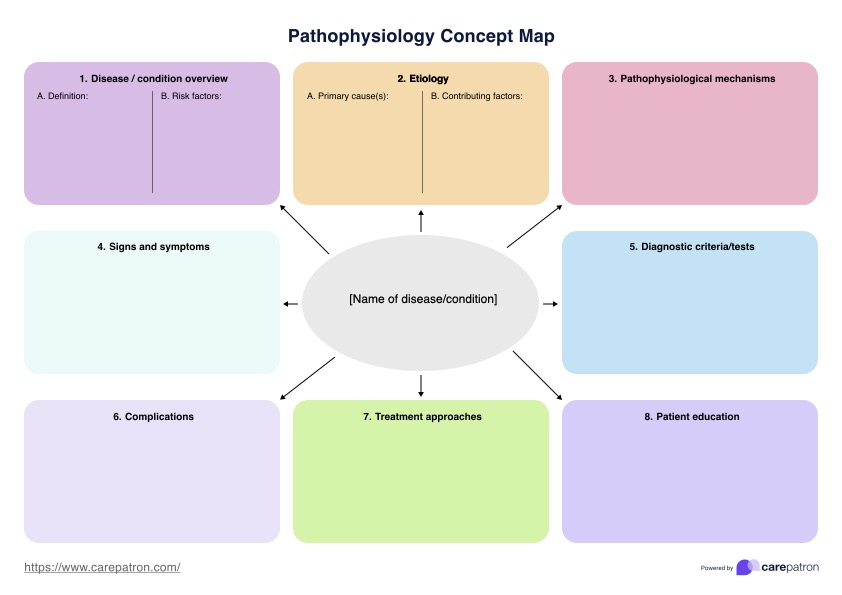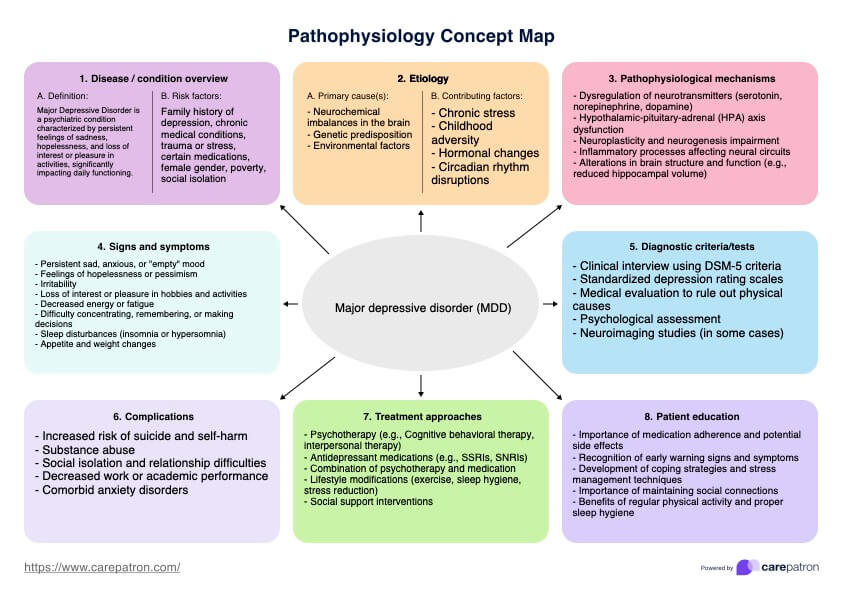Pathophysiology Concept Map
Effortlessly understand pathophysiology through our concise and user-friendly Pathophysiology Concept Map.


What is a Pathophysiology Concept Map?
A Pathophysiology Concept Map is an educational tool commonly used in nursing and medical education to visually represent the relationships between different components of a disease process. It helps learners understand how various factors, such as risk factors, symptoms, and underlying mechanisms, interact within the body to influence disease outcomes. These visual aids provide an organized way to study complex pathophysiological concepts, making it easier for students and professionals to grasp how diseases develop and progress.
Pathophysiology Concept Maps are particularly effective for enhancing the retention and understanding of complex information. Organizing data in a coherent visual format allows users to identify patterns, recognize cause-and-effect relationships, and appreciate the body's intricate responses to different pathophysiological challenges. Nursing students often use these maps to focus on critical aspects of diseases, facilitating better learning experiences and deeper comprehension of pathophysiological concepts.
Pathophysiology Concept Map Template
Pathophysiology Concept Map Example
The importance of understanding pathophysiology in nursing
In the field of nursing, a deep understanding of pathophysiology is essential for delivering high-quality care. By grasping the underlying mechanisms of diseases through the use of tools like a concept map for pathophysiology, nurses can make more informed decisions, improve patient outcomes, and enhance their professional expertise.
- Accurate assessment and diagnosis: By understanding how disease processes affect the body on a cellular and organ level, nurses can better connect patient symptoms to their underlying causes. This enables them to make more accurate assessments and initiate earlier diagnoses, leading to faster interventions and improved outcomes. Utilizing a pathophysiology map can be particularly helpful in this process.
- Informed care planning and intervention: Once the pathophysiology of a patient's condition is identified, nurses can tailor a targeted care plan that addresses the specific mechanisms causing the problem. This may involve medication, therapies, or other interventions to correct the underlying dysfunction. A patho concept map can be valuable in designing these care plans.
- Anticipating potential complications: Knowing the common complications associated with different diseases allows nurses to proactively monitor patients for early signs and symptoms. This enables them to take preventive measures to avoid or minimize complications, enhancing patient safety and comfort.
- Effective patient education and communication: By explaining the pathophysiology of their condition in understandable terms, nurses can empower patients to take an active role in their care. This can involve lifestyle changes, medication adherence, or participation in specific treatment programs.
How to use a concept map
Concept maps are valuable tools that help organize and visualize complex information, making them particularly useful in healthcare. By clearly mapping out the relationships between different concepts, such as in our provided Pathophysiology Concept Map example, these diagrams can aid in the understanding of disease processes, treatment strategies, and patient care plans. Using a Pathophysiology Concept Map PDF effectively requires a step-by-step approach to capture and understand all relevant information.
Orient yourself
Begin by understanding the map's overall structure and main concepts. Identify the central disease or condition being represented. Note the key categories (e.g., etiology, pathogenesis, signs and symptoms) and their arrangement.
Trace the flow
Follow the arrows to understand how different concepts connect and interact. Observe how one concept leads to, contributes to, or impacts another. Note that our template is also customizable, so you can add or retrace arrows to link concepts between each field.
Analyze relationships
Examine the connections to identify critical patterns and relationships between concepts. Consider how various factors contribute to disease development or influence its manifestations. Understand how different symptoms and complications are interconnected.
Ask questions
Use the map as a springboard for inquiry and critical thinking. Pose questions like: "What are the primary risk factors?", "How does the disease progress?" "What are the potential treatment strategies?"
Who is this Pathophysiology Concept Map for?
The Pathophysiology Concept Map is valuable for nursing professionals, students in nursing school, and healthcare practitioners. It is an interactive and user-friendly template for individuals seeking a structured, insightful approach to understanding complex diseases in the health sciences.
Whether you are a nursing student looking to enhance your learning experience or a healthcare professional aiming to organize and communicate critical pathophysiological concepts, this concept map is tailored to meet your needs.
It provides a comprehensive and visually engaging platform to explore disease mechanisms, risk factors, symptoms, and relevant factors within the human body. The Pathophysiology Concept Map is suitable for those who aim to elevate their understanding of pathophysiology for effective patient care and improved learning outcomes.
Benefits of this Pathophysiology Concept Map
The Pathophysiology Concept Map significantly benefits nursing students, healthcare professionals, and educators. It enhances understanding by clearly visualizing complex disease processes, helping users grasp how various factors interact within the body. This structured approach aids in better retention and recall of critical information, making it a valuable study tool for exams and clinical practice.
Additionally, the concept map supports efficient patient care planning by illustrating the relationships between different aspects of a disease. This enables healthcare professionals to develop targeted interventions and make informed decisions, improving patient outcomes. It also serves as an effective tool for patient education, allowing complex conditions to be explained in an understandable way and empowering patients in their care.
Moreover, the Pathophysiology Concept Map promotes continuous learning and professional development by providing a comprehensive overview of disease mechanisms. Its customizable and user-friendly design makes it adaptable to various educational needs, ensuring that it remains a relevant and valuable resource in healthcare.
Research and evidence supporting concept maps
Research supports the integration of concept mapping in medical education, highlighting its effectiveness in enhancing learning outcomes and fostering a deeper understanding of complex concepts. For instance, a study conducted at NOVA Medical School during the academic years 2017-18 and 2018-19 assessed the impact of pedagogical changes in concept mapping methodology within the pathophysiology curriculum. Results showed positive feedback and improved performances, which were attributed to core concept identification and mini-map construction changes. Students emphasized the utility of these changes, particularly their inclusion in final global maps (Fonseca et al., 2020).
Similarly, a study involving third-year MBBS students in India revealed a significant improvement between pretest and posttest scores, demonstrating the effectiveness of concept maps in enhancing students' knowledge. More than 50% of students scored full marks in the posttest, and the majority (82.09%) responded positively to using concept maps, reinforcing their effectiveness as a teaching and learning tool in medical education (Walvekar et al., 2021).
These studies underscore the importance of incorporating concept mapping into medical education to improve student understanding, promote meaningful learning, and enhance overall academic performance.
References
Baliga, S., Walvekar, P., & Mahantshetti, G. (2021). Concept map as a teaching and learning tool for medical students. Journal of Education and Health Promotion, 10(1), 35. https://doi.org/10.4103/jehp.jehp_146_20
Fonseca, M., Oliveira, B., Carreiro-Martins, P., Neuparth, N., & Rendas, A. (2020). Revisiting the role of concept mapping in teaching and learning pathophysiology for medical students. Advances in Physiology Education, 44(3), 475–481. https://doi.org/10.1152/advan.00020.2020
Commonly asked questions
It's a visual tool that organizes and connects key concepts about a disease or condition, illustrating its causes, development, consequences, and management.
Anyone can benefit from them by clearly understanding and organizing complex disease processes, including students, healthcare professionals, and patients.
Trace the connections between concepts, analyze relationships, and ask questions to deepen your understanding of the disease and how its various elements interact.












































































































